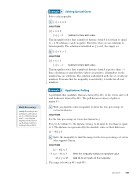Page 620 - Algebra 1
P. 620
Example
4
Solving Special Cases
Solve each inequality.
a. x +6≤4 SOLUTION
x + 6 ≤ 4
x ≤ -2 Subtract 6 from both sides.
This inequality states that a number’s distance from 0 is less than or equal to -2. No distance can be negative. Therefore, there are no solutions to this inequality. The solution is identified as { } or ∅, the empty set.
b. x +6>1 SOLUTION
x + 6 > 1
x > -5 Subtract 6 from both sides.
This inequality states that a number’s distance from 0 is greater than -5. Since all distances (and absolute values) are positive, all numbers on the number line are solutions. The solution is identified as , the set of all real numbers. It means that the inequality is an identity; it works for all real numbers.
Application: Polling
A poll finds that candidate Garcia is favored by 46% of the voters surveyed and Jackson is favored by 44%. The poll has an accuracy of plus or
minus 3%.
a. Write an absolute-value inequality to show the true percentage of voters for Garcia.
SOLUTION
Let the true percentage of voters for Garcia be g.
For g to be within 3%, the distance from g to 46 must be less than or equal
to 3. The distance is represented by the absolute value of their difference. g - 46 ≤ 3
b. Solve the inequality to find the range for the true percentage of voters who support Garcia.
SOLUTION
g - 46 ≤ 3
-3 ≤ g - 46 ≤ 3 Write the inequality without an absolute value.
43 ≤ g ≤ 49 Add 46 to all 3 parts of the inequality. The range is between 43% and 49%.
Example
5
Math Reasoning
Justify According to the poll, Garcia and Jackson are in a “statistical dead heat”— a tie. Explain why the poll would not say that Garcia (46%) is leading Jackson (44%).
Lesson 91 605


